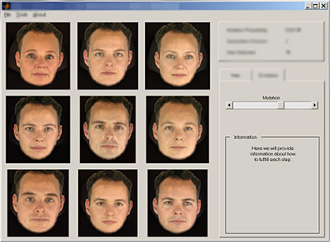
|  |  |  Technology News | October 2009 Technology News | October 2009  
Police Sketch Artist Evolves
 Angela Stark - Optical Society of America Angela Stark - Optical Society of America
go to original
October 06, 2009


| | Computer program uses interactive genetic algorithm to help witnesses remember criminals in police departments across Europe. |  |
Washington - Criminals are having a harder time hiding their faces, thanks to new software that helps witnesses recreate and recognize suspects using principles borrowed from the fields of optics and genetics.

Next week, Christopher Solomon of the University of Kent in Canterbury, England will present the software, called the EFIT-V system, at the Optical Society's (OSA) Annual Meeting, Frontiers in Optics (FiO), which will take place Oct. 11-15 in San Jose, Calif.

The software is being used by approximately 15 police departments in the United Kingdom and by a half dozen European countries, including France and Switzerland. In field trials conducted by the Derbyshire police force, it led to twice as many identifications of suspects as traditional methods.

Law enforcement agencies around the world traditionally employ sketch artists, who piece together faces in a process similar to assembling a Mr. Potato Head toy. The witness describes key features - such as hair length, nose size or sharpness of the chin - and the artist combines them to create a likeness. Some departments now have computer programs that follow the same approach as these artists, creating facial composites using databases of pre-drawn features.

The problem with this approach, says Solomon, is that it doesn't take into account how the memory actually works. "There's quite a bit of research in the psychology field suggesting that we're not so good at this, at recalling and describing a face," says Solomon.

His software generates its own faces that progressively evolve to match the witness' memories. The witness starts with a general description such as "I remember a young white male with dark hair." Nine different computer-generated faces that roughly fit the description are generated, and the witness identifies the best and worst matches. The software uses the best fit as a template to automatically generate nine new faces with slightly tweaked features, based on what it learned from the rejected faces.

"Over a number of generations, the computer can learn what face you're looking for," says Solomon.

The mathematics underlying the software is borrowed from Solomon's experience using optics to image turbulence in the atmosphere in the 1990s. "I then realized that the same technique could be applied to human faces, which in many respects are mathematically similar to turbulent wavefronts," said Solomon.

The software integrates this approach with an interactive genetic algorithm that progressively changes the features based on principles borrowed from evolution. Characteristics such as nose size and chin sharpness are represented as mathematical genes that mutate. As the features change, the witness' selections guide the evolution of the face.

Other researchers have used similar interactive genetic algorithms to train computers to compose music, says Solomon, by selecting pleasing combinations. Genetic algorithms have also been used in the automobile industry to customize the look of body work.

One advantage of this technique, says Solomon, is that it can be used on witnesses who can't recall details about a suspect - but say that they would remember the face if they saw it again. Traditionally, police sketch artists cannot work with these people. By tapping into recognition instead of recall, "the EFIT-V system proved to be quite effective even when witnesses say they can't describe a person," says Solomon.

The software has now started to make its way to the United States, where it being used by researchers in university settings. In the future, Solomon hopes to partner with a suitable U.S. company and market the technology to police departments.

astark(at)osa.org

FiO 2009 is OSA's 93rd Annual Meeting and is being held together with Laser Science XXV, the annual meeting of the American Physical Society (APS) Division of Laser Science (DLS). The two meetings unite the OSA and APS communities for five days of quality, cutting-edge presentations, fascinating invited speakers and a variety of special events spanning a broad range of topics in physics, biology and chemistry. The FiO 2009 conference will also offer a number of Short Courses designed to increase participants' knowledge of a specific subject while offering the experience of insightful teachers. An exhibit floor featuring leading optics companies will further enhance the meeting.

About OSA: Uniting more than 106,000 professionals from 134 countries, the Optical Society (OSA) brings together the global optics community through its programs and initiatives. Since 1916 OSA has worked to advance the common interests of the field, providing educational resources to the scientists, engineers and business leaders who work in the field by promoting the science of light and the advanced technologies made possible by optics and photonics. OSA publications, events, technical groups and programs foster optics knowledge and scientific collaboration among all those with an interest in optics and photonics. For more information, visit: www.osa.org.
 |

 |
|  |



